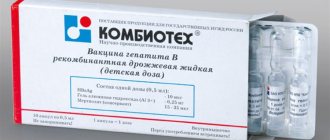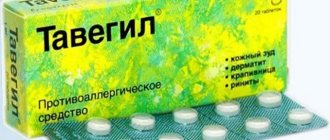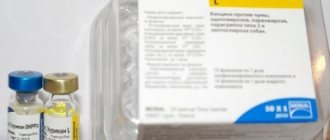What is a vaccine
The letters ADS-M are an abbreviation that has the following meaning: “Diphtheria-Tetanus Anatoxin.” The prefix “M” means a low concentration of active substances. As a result, the patient receives a full-fledged vaccine, but with a reduced number of active antigens.
You may be interested in:Aspartic acid: formula, properties, application, side effects
ADS-M is an injection that protects a person from such dangerous diseases as tetanus and diphtheria. Moreover, adults need vaccination just as much as small children, in some situations. The injection consists of fully purified diphtheria and tetanus toxoids adsorbed on aluminum hydroxide. The substances are weakened pathogens of dangerous diseases. At the same time, they can affect the human body just enough so that the immune system begins to actively produce antibodies against “aliens,” but without harming health.
"ADS-M-Anatoxin" - a drug for the prevention of diphtheria and tetanus
The drug is diphtheria-tetanus toxoid, purified, adsorbed with a reduced content of antigens, liquid. Combined bivalent vaccine
, Russia.
Protects against diseases: tetanus, diphtheria. The administration of the drug causes the formation of specific antitoxic immunity.
Suitable for: children over 6 years old, teenagers and adults.
Included in the national calendar of preventive vaccinations in Russia.
Advantages of the ADS-M-Anatoxin vaccine
- vaccination with the ADS-M-Anatoxin vaccine guarantees a high degree of protection against two dangerous infections simultaneously
- administration of the ADS-M-Anatoxin vaccine is a low incidence of local reactions compared to another vaccine with a higher content of toxoids
- The introduction of the ADS-M-Anatoxin vaccine causes the formation of a stable immune memory in the child’s body. During revaccination, rapid formation of antitoxins occurs in high concentrations.
- it is possible to use the ADS-M-Anatoxin vaccine for emergency vaccination within 20 days in case of injury and contact with the ground, in case of contact of a child with a sick person, in epidemic foci
- the ADS-M-Anatoxin vaccine can be administered simultaneously (on the same day) with any inactivated vaccines and live chickenpox vaccine, provided injections are made into different parts of the body
How does the injection affect the body?
Most patients, when they are offered an injection, do not understand what they are getting the ADS-M vaccine for. During the injection, live but weakened toxins are introduced into the body of an adult. They retain their special immunogenic properties, but are not able to have a negative effect. As a result, the body detects their presence and begins to actively produce antibodies. Subsequently, if a real infection occurs, it is these substances that will fight the causative agent of tetanus or diphtheria.
Experts will explain that vaccination leads to an erased form of the present disease. But the difference is that there is no threat to health and life, and the person gains immunity for many years.
Who is the injection indicated for?
ADS-M vaccination is indicated for adults. The doctor can tell you in detail why it is done. An injection is necessary to protect the patient from the dangerous manifestations of tetanus and diphtheria and is given every ten years of a person’s life. If the recommended regimen is violated and more than twenty years have passed since the last vaccination, then for complete protection the injection should be given twice. In medical practice it looks like this:
- the patient is injected with the vaccine and his condition is monitored;
- if there are no complications, a repeat dose is administered after forty days.
Only in this case can a person be considered completely protected from dangerous diseases.
You may be interested in: The best mammologist in Moscow: rating and patient reviews
There are situations when the patient has never been vaccinated at all. In this case the following diagram is shown:
- after the examination, they give the first injection and observe the reaction;
- if there are no symptoms of intolerance, a second vaccine is given after forty days;
- To consolidate the result, it is important to make a third injection after a year.
Reviews
Patient
25.05.2021
MEDSI Clinic in Krasnogorsk
I would like to express my gratitude to nurses Sukhova I.V. and Tamonova Yu.V. and general practitioner Kovalevsky, who carried out the vaccination at the highest professional level and with great understanding of elderly patients. Thanks to all the staff for their efficient and friendly work.
Patient
27.01.2021
Clinical diagnostic center MEDSI on Krasnaya Presnya
Thanks to the Department of Internal Medicine for conducting vaccinations.
Ilya Vladimirovich
08.10.2020
Clinical diagnostic center MEDSI on Krasnaya Presnya
I would like to express my gratitude to the head of the therapeutic department (unfortunately, I did not remember the last name) for timely information about the availability of the Ultrix flu vaccine and for organizing my vaccination.
All reviews (7) Leave a review
Contact us by phone
+7 (495) 7 800 500
You will receive an automatic call back, wait for the operator to respond.
Make an appointment online
Policy regarding the processing of personal data Consent to the processing of personal data
Or via the app
Special cases
The ADS-M vaccine can also be given in emergency cases for medical reasons. If a person is diagnosed with injuries and wounds that have received soil and the vaccination was done more than five years ago, then an injection will be a mandatory procedure.
Elderly people especially need revaccination (repeated injections). They often have an increased susceptibility to infections due to reduced immunity. Therefore, doctors advise this category of patients not to neglect vaccination and not to refer to the presence of chronic diseases. Moreover, such pathologies are a direct indication for mandatory vaccination.

Contraindications
MEDSI employs experienced specialists who, during an initial consultation, will be able to determine indications and contraindications for vaccination and draw up an individual vaccination schedule.
So, you should refrain from vaccination in the following cases:
- Severe reaction or development of complications after a previous vaccination (fever, swelling, anaphylactic shock, convulsions)
- Immunodeficiency
- ARVI with fever
- Exacerbations of chronic diseases (diabetes, kidney disease, etc.)
- Blood transfusion in the recent past
- Severe prematurity and slow weight gain
- Oncological diseases
- For some vaccines, hypersensitivity to yeast or egg white
ADS-M. What is the vaccine for and where is it given?
Tetanus and diphtheria toxoid is produced in the form of a white suspension, which during storage separates into sediment flakes and a white liquid. Therefore, before opening the ampoule, it is recommended to shake it vigorously until smooth.
The ADS-M vaccine has quite mixed reviews. Why and where the injection is given causes multiple disputes between patients. You can often find responses from people who claim that they were given an injection in the buttock. Others claim that vaccination took place under the shoulder blade.
Doctors clarify this situation and claim that ADS-M toxoid can be placed both in the scapular part of the back and in the buttocks area. Moreover, there is also a third option. The injection is allowed to be placed in the middle third of the outer thigh. A single dosage of the medicine is 0.5 ml.
Vaccination may cause an allergic reaction. Therefore, the patient is not recommended to leave the treatment room where he is being monitored for half an hour. To be able to provide first aid, anti-shock therapy medications must be available in the office.
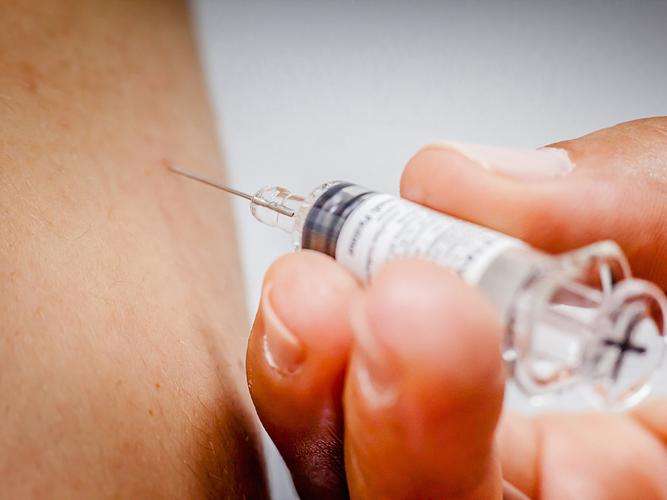
Scheme and method of administration of the vaccine "ADS-M-Anatoxin"
"ADS-M-Anatoxin" is administered intramuscularly to adults into the anterior outer part of the thigh, and to children and adolescents - deep subcutaneously into the subscapular region at a dose of 0.5 ml. Before vaccination, the ampoule must be thoroughly shaken until a homogeneous suspension is obtained.
"ADS-M-Anatoxin" is used:
- For vaccination of children 6-7 years of age and older who have not previously been vaccinated against diphtheria and tetanus. The vaccination course consists of two vaccinations with an interval of 30-45 days. Reducing the interval is not allowed. If it is necessary to increase the interval, the next vaccination should be carried out as soon as possible. The first revaccination is carried out 6 - 9 months after the completed vaccination once, the second revaccination is carried out at an interval of 5 years. Subsequent revaccinations are carried out in accordance with paragraph 2.
- For planned age-related revaccinations at 6-7 and 14 years of age, then every subsequent 10 years without age limitation. Adults vaccinated with tetanus toxoid (TA) less than 10 years ago are vaccinated with AD-M toxoid.
- As a replacement for DTP vaccine (DTa toxoid) in children with severe general reactions or post-vaccination complications to these drugs. If a reaction has developed to the first vaccination with DTP vaccine (ADS-anatoxin), then the second vaccination is carried out with “ADS-M-Anatoxin” no earlier than 3 months later. If a reaction has developed to the second vaccination with DTP vaccine (DTa toxoid), then the course of vaccination against diphtheria and tetanus is considered completed. In both cases, the first revaccination with ADS-M-Anatoxin is carried out after 9-12 months. If a reaction has developed to the third vaccination with DTP vaccine (ADS-anatoxin), the first revaccination with “ADS-M-Anatoxin” is carried out after 12-18 months.
- To carry out a course of vaccination for adults who have not previously been reliably vaccinated against diphtheria and tetanus, a full course is carried out (two vaccinations with ADS-M-Anatoxin with an interval of 30 days and revaccination after 6-9 months).
Vaccination procedure
ADS-M vaccination requires compliance with certain rules. Why and where the injection is given is discussed above; the procedure should only be performed by a specially trained medical worker in a treatment room. In this case, the basic conditions must be adhered to.
The injection is performed only with a disposable, sterile syringe. At the same time as vaccination against tetanus and diphtheria, a person can be vaccinated against other diseases. However, the use of BCG is prohibited. It is also unacceptable to mix all substances in one syringe. Each injection is given separately and in different parts of the body.
You may be interested in: APTT analysis: norm, reasons for increase and decrease, interpretation of results
Before starting the procedure, the nurse must carefully examine the ampoule to ensure its suitability. If there is no information about the vaccine on the bottle, or it is damaged and the contents have a suspicious consistency, then it is prohibited to administer it. It is important to comply with storage conditions and pay attention to expiration dates.
The procedure is carried out under conditions that fully comply with antiseptic requirements. The ampoule is opened, drawn into a syringe and used entirely. If for some reason it was not possible to use all the contents, the bottle is discarded. It can no longer be stored.
It is necessary to enter patient data into a special registration journal. The following information is also entered there:
- vaccine serial number;
- date of its production;
- date of vaccination;
- reaction to the injection.
The patient's condition should be closely monitored. If after thirty minutes the state of health is beyond doubt, then you can leave the medical facility.
Contraindications for injection
ADS-M is a serious medical drug. The instructions clearly state situations when it is prohibited to give an injection. Contraindications for unvaccinated adult patients include:
- severe diseases associated with immunodeficiency;
- allergic reaction to vaccine components;
- negative reaction to the previous injection.
In addition, there are restrictions on injection. It is necessary to postpone the procedure in women during pregnancy and lactation. If the patient has suffered from acute infectious infections, then a medical exemption is given for two weeks.
Anatoxin ADS-M 1 ml (2 doses) N10 suspension for injection
Latin name
ANATOXINUM STAPHYLOCOCCUS
Release form
Purified staphylococcal toxoid is a staphylococcal toxin neutralized by formaldehyde and heat, purified from ballast proteins. Transparent liquid, colorless or light yellow.
Package
1 ml - ampoules (10) - cardboard packs.
pharmachologic effect
It has antitoxic, antimicrobial, immunomodulatory and immunocorrective effects, and is capable of inducing the formation of antistaphylococcal immunity directed both against the microbe and against the toxin.
Indications
Specific immunotherapy for acute and chronic (in the acute stage) staphylococcal infection in adults.
Contraindications
Contraindications for the use of purified staphylococcal toxoid are: acute infectious and non-infectious diseases of non-staphylococcal etiology, chronic diseases of non-staphylococcal etiology in the acute stage or decompensation - vaccinations are carried out no earlier than 1 month after recovery (remission).
Use with caution if there is a history of severe allergic reactions (anaphylactic shock, Quincke's edema); during pregnancy (since there is insufficient data on the safety of the drug in pregnant women).
Use during pregnancy and breastfeeding
There is insufficient data on the safety of using the drug Staphylococcal purified liquid anatoxin in pregnant women.
special instructions
The drug contained in ampoules with damaged integrity, labeling, changes in physical properties (presence of turbidity, flakes), expired, or in violation of storage conditions is not suitable for use. Opening the ampoules and administering the drug to patients is carried out in strict compliance with the rules of asepsis and antisepsis. The drug cannot be stored in an opened ampoule. Treatment with purified liquid staphylococcal toxoid can be carried out simultaneously with other general and local therapy, with the exception of immunoglobulins and antistaphylococcal plasma
Compound
- Solution for subcutaneous administration: 1 ml;
- staphylococcal toxoid: 10-14 EU
Directions for use and doses
Staphylococcal toxoid, purified, is injected subcutaneously under the lower corner of the scapula, alternating the right and left sides with each subsequent injection. Intramuscular use of the drug is not allowed.
The drug contained in ampoules with damaged integrity, labeling, changes in physical properties (presence of turbidity, flakes), expired, or in violation of storage conditions is not suitable for use. Opening the ampoules and administering the drug to patients is carried out in strict compliance with the rules of asepsis and antisepsis.
The drug cannot be stored in an opened ampoule.
The full course of treatment includes 7 injections of the drug, given at intervals of 2 days, in the following increasing doses: 0.1-0.3-0.5-0.7-0.9-1.2-1.5 ml.
With a rapid clinical effect, the course of therapy at the discretion of the treating physician can be reduced to 5 injections.
Side effects
Administration of the drug may be accompanied by general, local and focal reactions.
General reactions are characterized by mild weakness, malaise, and occasionally an increase in temperature to 37.5 °C. Local reactions are characterized by hyperemia and mild pain at the injection site, disappearing after 1-2 days. Often, after injection of the drug, a focal reaction may occur, i.e. exacerbation of the process at the place of its localization. The occurrence of these reactions is not a contraindication for continued treatment. However, if there are both general and local reactions, the interval between the previous and subsequent injections of the drug is recommended to be increased by 1 day. The development of a focal reaction does not require an increase in the interval between injections.
Drug interactions
Treatment with purified staphylococcal toxoid can be carried out simultaneously with other general and local therapy, with the exception of immunoglobulins and antistaphylococcal plasma.
Storage conditions
In a dry place, protected from light, at a temperature of 2–8 °C. (do not freeze).
Best before date
2 years.
Side effects
The ADS-M vaccine has quite mixed reviews. Not all patients like where the injection is given. In addition, the location may vary. If they were injected under the shoulder blade, patients complain of the inability to raise their arm, if in the buttock, then sometimes it hurts to sit down. The responses are all different. Some feel nothing, others develop a fever. Frequent complaints are:
- redness at the injection site;
- runny nose and general malaise;
- muscle pain at the injection site.
However, doctors claim that such a reaction to the vaccine is normal. Such conditions indicate the body’s struggle against “aliens” and the development of stable immunity. Usually, after some time, negative symptoms go away on their own. After all, this vaccination is considered one of the less reactogenic.

Side effects can be mild, but sometimes become more severe. It is especially important to monitor the patient's condition in the first 48 hours. At this time, the temperature often rises, redness and swelling appear at the injection site. If a lump appears, there is no need to panic. It resolves on its own within a couple of weeks. However, doctors warn that in order to avoid suppuration, heating this place is prohibited.
Experts emphasize that even a severe reaction to a vaccine is not considered a pathology. There will be no consequences for health, even if a person feels very uncomfortable in the first days. However, it is worth considering the possibility of a persistent allergic reaction, which may serve as a contraindication to revaccination.

Vaccine analogues
The ADS-M vaccine has several analogues. What it is given for is a priority in choosing the appropriate injection. Analogues have a similar composition and mechanism of action. Differences in the country of origin.
- “D.T. Vax." French pharmaceutical. French production.
Of course, the choice will depend on the availability or absence of a particular drug in a medical facility. You can purchase the desired vaccine yourself, but as reviews show, the Russian product is no worse than its imported counterparts.
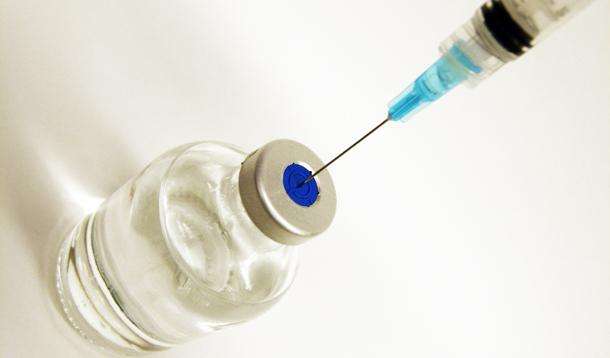
Reviews about the vaccine
The ADS-M vaccination is adsorbed, that is, it does not have the pertussis factor. Therefore, injections, as numerous reviews show, are well tolerated. General complications are recorded quite rarely. Most often, patients complain of swelling and redness at the injection site. But such a manifestation is considered normal, so it is not considered an undesirable effect. The toxoid is not dangerous for humans. There are no reviews about serious health problems, but there are many reviews about protection from diseases.

Of course, there are allergic reactions to the injection. In this case, it is necessary to take antihistamines. If the situation is extremely difficult, then it is necessary to refrain from revaccination and, together with the doctor, look for a replacement.
Source
